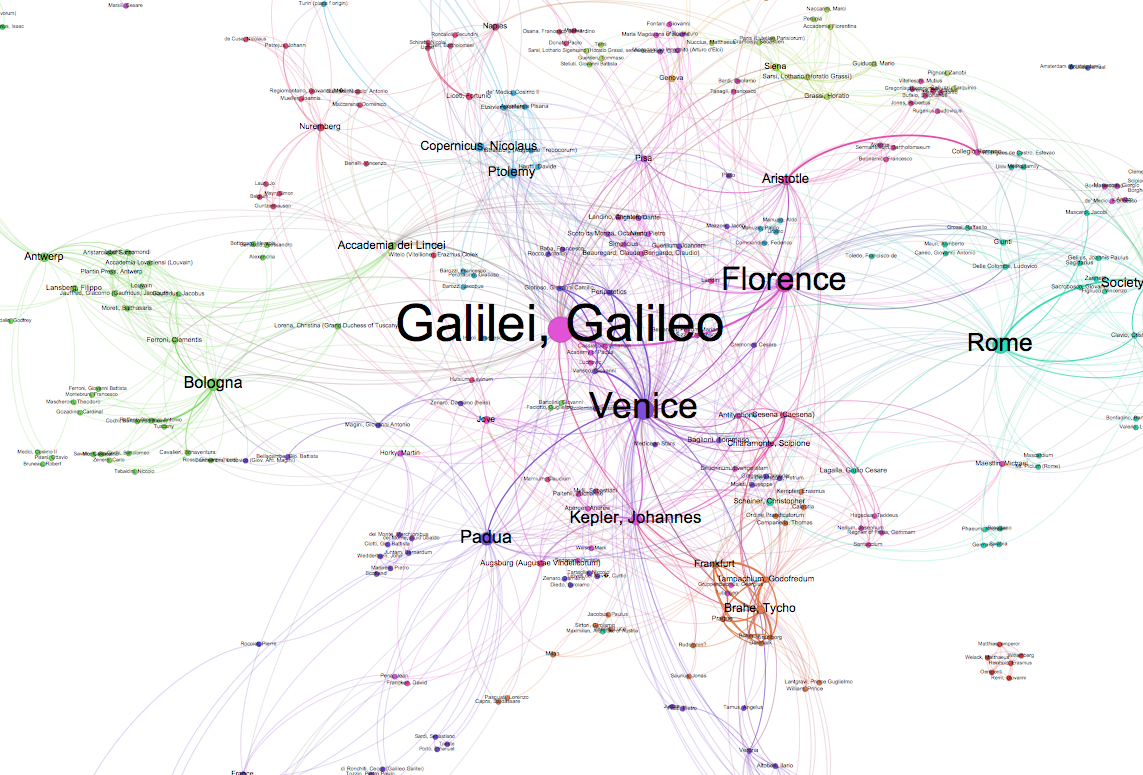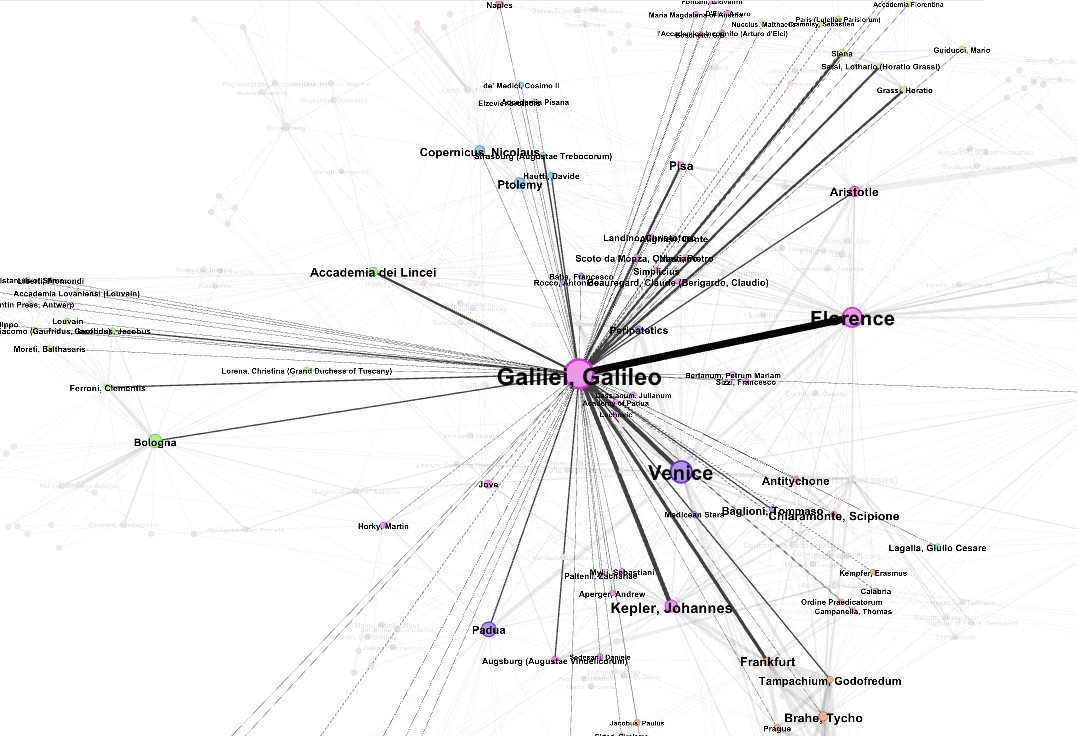People and Places Represented by the Title Pages of Books on Astronomy in Galileo’s Library
This example uses print culture represented by books, and knowingly omits, for now, an investigation of ephemeral prints such as brochures, flysheets, handbills, pamphlets, and other newly-minted print genres from this period.1 I recognize that these were particularly popular methods for distributing testimonials about comets and other sightings in the sky that fueled debate about the validity of the Aristotelian conception of the structure of the natural world. I also can’t address the question of books that might have been bound with other books, a common practice in the period, and one that is not addressed in any of the sources on Galileo’s library. Because full text is unavailable for this complete set, I am focusing on the data presented on their title pages. Since my analysis privileges the ways in which books were trying to advertise themselves to potential readers through the visual cues on the title page, relying on the formulation of the title to determine my subset respects the goals that I have for the visualizations you are about to see. That means that works are included such as Rafaelle Gualterotti’s L’universo, ovvero il Polemidoro, the heroic poem that he hoped to revise decades after its first edition once he had learned of Galileo’s findings.
I have documentation that Galileo owned all of these books at one point in his life, although not necessarily at the same moment. What unites all of these books is the desire to be considered a work on astronomy. They are texts written for the purpose of measuring, charting, predicting, or explaining the location or movement of planets and stars. For the time being, I have differentiated them from the more complex body of classical and medieval texts that were adopted by practitioners of natural philosophy as witnesses to and authorities on astronomical events. These include, for example, Virgil’s Georgics and Ovid’s Metamorphoses. What these 162 books represent when seen together are networks of authors, printers, patrons, editors, commentators, and printing centers. There is a tantalizing potential that examining this information from a perspective of digital network analysis can both reinforce the conclusions drawn by microhistories of early modern print in Italy and also reveal new paths for exploration. This subset of the library includes 162 books.
The data visualizations that you will see for the group of astronomy texts do not include a very small subset of books in Galileo’s library, seven that are related to astronomy, but for which the documentation only indicates a partial title, not a specific edition. Overall, I have this kind of incomplete information for nearly 200 of 670 titles that were known to have been in Galileo’s library. The fact that only seven of the 162 works related to astronomy fall into this category speaks to a number of characteristics of early modern printed works on this subject.

Overview of the network of books on astronomy. Color represents community (modularity), size indicates betweenness centrality, and label size indicates eigenvector centrality.
Click here to see the network visualizations in an interactive format. [The graph is still in draft form for teaching purposes and debugging.]
Color-coding is based on an algorithm to determine communities of highly interconnected groups in the network. The algorithm confirms the communities that we would have anticipated organized around geographical locations. Clockwise from the top: in orange we see Rome, the Collegio Romano and their shield of Aristotle (Galileo’s term, not mine, yet visualized so nicely by the algorithm); Venice is mostly green, but connected to several other communities outside Italy; red is Antwerp; yellow is Frankfurt with Kepler and Prague with Tycho Brahe; blue is the Parisian community; pale orange is the Bologna community of scholars; and Florence is the multicolored knot tied primarily to other Italian locations in the center.
The Question of Place
There were already over 100 presses at work in Italy by this time, and 55 of them produced books on astronomy in Galileo’s library. Yet, Andrew Pettegree’s comprehensive study, The Book in the Renaissance, has suggested that the material demands of printing scientific works limited production to high-end top producers who already controlled much of book culture in the period.2 Pettegree focuses on Basel and Nuremberg, but the cross section provided by the network suggests an Italian conversation, not a European one, and one that involves many smaller presses. We see the established European intellectual centers and Roman institutions on the edges of this graph, but the dynamism of the connectedness at the center speaks to the transitional moment of a marginal, controversial idea that is about to gain traction and become a dominant force in another language and culture entirely with Newton. Is this jumbled space of debate a proving ground or a quagmire?
This invites a consideration of the ways in which publishing centers may have been points of resistance to the dissemination of new ideas. Much lip service is paid to the value of the printing press for establishing access and assisting proliferation of ideas. If we think back to Baglioni and his heretical press though, perhaps we need to be asking deeper questions about the material and labor forces of book production that facilitated or debilitated an idea gaining traction, or at least finding space for debate. Other than Venice, the printing centers that hosted the debates that gave rise to Galileo’s articulation of the new natural philosophy are typically not considered major centers in early modern Europe, as Pettegree’s diagram shows. What characterized the other print spaces for debate for other topics and other countries?
The Question of Galileo

Subset of the graph that highlights Galileo’s connections to people and places. All visualization layouts are the same as above.
Click here to see the network visualizations in an interactive format.
Now, as a final point, let us turn back to that gray community with Galileo at the center and reaching out to the myriad groups represented by the different colors in the graph. What this suggests is that Galileo was the most connected person in his own library. More so even than the Jesuit Collegio Romano, Aristotle, Kepler, or Brahe, who round out the top five connected people or institutions in this graph. This suggests to me, at least, that this is a debate about Galileo and Aristotle, not Copernicus and Ptolemy. This is not because Galileo authored the most books on astronomy in his library. If we expand the data to include all of the books in the library Galileo is still the most connected person represented by his book collection. What this suggests is that he was able to witness his own impact on print culture during his lifetime. This is not the posthumous rise to fame that characterizes many authors before him. While Galileo is often omitted from discussions of the Republic of Letters because of the unfortunate fate of most of his primary documents, the network graph allows us a way to recreate that system of exchange and power dynamics.
[1] See Walsby & Constantini, 11-14.
[2] 274.